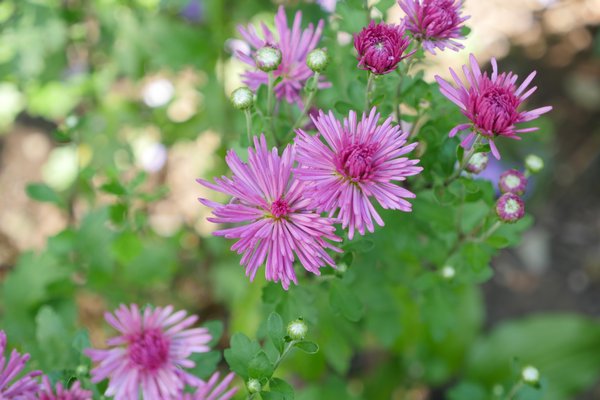

Back when I managed my first estate, I found a gallon pot in an old cold frame containing a lonely chrysanthemum (now botanically known as Dendranthema) with a delicate pink flower that was just begging for a home. The name tag was from the White Flower Farm and simply said “Single Korean Apricot.” I secreted the plant in a corner of a cutting garden and promptly forgot about it.The following year I was astonished. At first I thought the plant was a dud because it didn’t even set buds until early September, and this was so unlike the mums that we began disbudding way back in May to encourage large fall flowers. I was sure that frost would do it in well before it flowered, but by late October the plant matured into one of the most magnificent mums I’ve ever seen. It grew into a perfect mound about 18 inches tall and 3 feet in diameter, had a wonderful scent and was impervious to cold, bugs and a tortuous summer. What a find.
Unfortunately, most gardeners are unaware of just how versatile the chrysanthemum actually is (the Japanese are nearly obsessed with them). It’s gotten to the point where a reader from Wisconsin—yep, someone there reads this column—asked if everyone thinks mums are simply disposable and replaced every year. Once relegated solely to the fall garden, mums include ones like those in the Igloo series that flower in July and don’t finish until October, and some of the later varieties continue to bloom even as the outdoor temperatures hover around freezing. Indeed, the mums are a large and even confusing family. We’ve even got a variety that’s picked up a local common name, the Montauk daisy—actually native to Japan, where it’s known as the Nippon daisy—which blooms from late September through October and takes virtually any abuse that man and nature can heap on it. This mum can get pretty sloppy, but a trick noted at the end of this column can keep it short and quite attractive.
And as for form and texture, mums can be grown in flowing dense mats with tiny thimble-sized flowers to tall standards that are grown like trees to a height of 4 to 8 feet. There are also cascades that can be grown in hanging baskets and can trail down several feet from a crown that may be as large as 3 feet in diameter.
For the home gardener there are hundreds of varieties to choose from, with new—not always better—varieties being introduced each year. You’d never know about 90 percent of these new varieties if you simply went from one retailer to the next, because they are at the mercy of the wholesale growers that have limited their offerings to a couple dozen or so very common types that can be easily grown or forced for fall sales. And speaking of being forced, a reader once wrote to ask why the mum she had purchased in full bloom in May had died in her garden and not returned the following year. The answer was easy, as this was a mum that wasn’t intended for garden use but for indoor color. So when you see mums in brilliant color in the off seasons … the answer is no, they will likely not survive in the garden.
In reality the choices in fall-blooming mums range in height from 8 inches to nearly 4 feet tall in a wide range of flower types that can be up to 5 inches in diameter with some very intriguing shapes and characteristics. The National Chrysanthemum Society (mums.org) now lists well over 3,000 varieties that are being grown. And to give you an idea of the diversity—and what you’ve been missing)—the NCS recognizes 13 distinct types of mums that are displayed in flower shows and competition. The type that you are probably most familiar with is the pompon, which has a very rounded flower and is generally less than 2 inches in diameter. This is the type most commonly used as a cut flower, and they are imported as cuts from Colombia and Israel.
The cushion mum is most common in home landscaping and is usually double-flowered and 2 to 3 inches in diameter. They are called “cushion” because they are bred to be short and compact, which makes them ideal choices for mass plantings and in the front of a border. The button types have a similar flower to the pompon, but the flowers are even smaller. The Rayonettes were not the backup group for Ray Charles, but a group of mums often referred to as “spider” mums, as they have long thin petals that are somewhat tubular.
The types commonly referred to as “daisies” are actually singles, which have only a single row of petals with a center eye in contrasting color. The most common one that you are probably familiar with is the ox-eyed daisy, aka the shastas. Anemone types have a layer of outer petals and a fluffy central eye of a contrasting color, while the spoons have many full, tubular petals, which open to a “spoon” much like the spoons that you get with a certain frozen treat at 7-Eleven. Generally these mums also have a central, colored disk. Among the less common types are aster flower reflex, Japanese incurve, Chinese incurve, the reflexes, quills and threads.
Careful planning and planting can result in blooms from late June to late fall, and contrary to what you might believe, none will need forcing or special lighting tricks to make them bloom on time each year. However, the same variety grown in full, direct sunlight and grown on the same property where it gets one or two hours less of sunlight will flower weeks apart. It’s the varietal choices that you make that will also determine flowering time, though some tricks of the trade can stall or hasten the formation and opening of the blooms.
All of the mums require full sun for at least six hours a day, and when they are planted in the shade they get leggy and very unsightly. Many older gardens still contain some magnificent chrysanthemum specimens, but through multiple owners and the filling in of the overhead canopy they have been lost in the garden. When they are rediscovered as chrysanthemum-like weeds, they’re merely tossed away. Transplanting to a sunnier location and some corrective spring pruning will yield some extremely wonderful surprises from what was mistaken for a weed.
It is the spring and summer care that will determine the quality and quantity of flowers during the second year. The plants do most of their growing when the weather is hot in June, July and August, so these are the months when the plants will need regular feeding. A granular organic fertilizer around the 1-2-1 applied several times during the season will suffice, as will a number of the time-released fertilizers.
The gentle art of pinching will keep your plants from getting too tall, and the proper application of this technique can result in many small flowers (heavy pinching with no disbudding) or large flowers (heavy pinching with selective disbudding).
Pinching starts when plants are 6 inches high and continues until early July. You can begin your collection of mums by gathering cuttings in the spring and rooting them in sand or a peat-lite mix, getting spring-dug divisions from friends, or by starting them from seed, or by ordering through the mail, where you’ll probably find the largest selections, including those from Bluestone Perennials. Now, if you really want a treat and a good dose of inspiration, try to visit Longwood Gardens in Kennett Square, Pennsylvania, from October 24 through November 22 for their Chrysanthemum Festival. Dozens and dozens of varieties will be on display in mounds, globes, columns, cloud-pruned topiaries and single stems with 7-inch flowers. In all there are more than 15,000 mums on display, and considering the rest of the festival activities you’ll leave tired, but pleased. It’s a nice weekend trip, but if you’ve got a free weekday, or two, the crowds are smaller and the show that much better.
Ah, and the trick to great-looking Montauk daisies? Cut them back to 12 inches in late June. They’ll come back with shorter, stronger, bushy stems that are full and lush with flowers when all the summer folk have gone home and we’re left here to enjoy it all. Keep growing.
 More Posts from Andrew Messinger
More Posts from Andrew Messinger